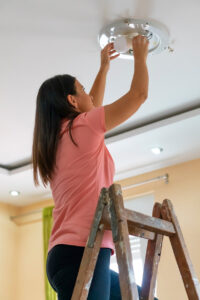Bedroom Sensor Lights
Motion Sensors Light Guide 2022
Let's shed a little motion-sensitive light on motion-sensitive light

Staff Writer, Home Security & Smart Home
Read More
Published on November 05, 2021
Some lights automatically go on when you enter a room or step onto a front porch. When that happens, motion sensor lights are in play.
If you wish you had some of that technology for your own, well, you can. Keep reading to learn more about motion sensor lights and how you can get them.
What are motion sensor lights?
Motion sensor lights are a bit more advanced than your typical lights.
A motion sensor light is attached to a motion sensor. (Big shock, we know.) When human movement triggers the sensor, the light turns on.
Further reading
How do motion sensor lights work?
Motion sensor lights react to movement.
Let's talk about how a motion sensor light works.
Motion sensors
To have a motion sensor light, you first need a motion sensor, aka a motion detector. There are a few different types of motion detectors, such as the following:
- Passive infrared (PIR)
- Active infrared (sometimes also called area reflective)
- Photoelectric
- Microwave
- Dual technology
Check out our motion sensors guide for more information.
Motion sensors lights
As we mentioned before, a motion sensor light is turned on by the motion sensor. That usually means that the light will automatically turn on as soon as this sensor (also called an occupancy sensor) notices you.
There may also be a mechanism to turn the light on manually, but not always.
Typically, the light remains on either for a set time or as long as it senses the movement. If you've ever sat on a public toilet and the bathroom light suddenly turned off, you probably know what we're talking about.
Further reading
Do you need motion sensor lights?
There are a lot of different reasons why someone might like a motion-activated light.
A motion sensor light can make you feel like you're truly living in the future. But that doesn't mean everyone needs to purchase them willy-nilly.
Here are some typical reasons you might want to consider buying motion sensor lights.
You like convenience.
Imagine never flipping a light switch again. If that sounds appealing, motion-sensitive lights await you.
You want to save energy.
No more leaving the lights on. If no one's around, your home will stay dark.
You want to discourage prowlers and thieves.
Outdoor motion sensor lights (especially if they're floodlights or spotlights) can deter criminals. Without darkness to cover their tracks, they may flee from your home.
Motion sensor lights can also be useful for some people with disabilities.
Further reading
What features should you look for in motion sensor lights?
Your needs will dictate your light choice.
There's a lot to think about when it comes to choosing a motion sensor light.
Bulb type
There are several different types of bulbs on the market.

- LED (light-emitting diode): Light is produced by diodes, a component with electrodes that electricity passes through
- Incandescent: Light is produced by a heated wire filament²
- Fluorescent: Light is produced by a chemical reaction³
There are pros and cons to each bulb type. For instance, LED lights tend to last longer than incandescent lights, but they also cost a lot more than most incandescent lights.⁴
Most outdoor lights come with a particular bulb type already installed, while most indoor lights are just a single bulb. So if you have a strong opinion about which bulb to use, make sure to check the light specs before you buy.
A halogen light or halogen lamp is a type of incandescent light.⁵
Light pattern
Do you want a typical light pattern that gently disperses throughout a room or yard? Or would you like a floodlight (that illuminates a large space) or a spotlight (that puts an intense focus on one person or object)?
Floodlights and spotlights tend to be more common in outdoor lights.
If you're getting a light for security purposes, a floodlight or spotlight is probably the best choice. But if you aren't looking for anything special, a generic pattern ought to do ya.
Power source
Your three choices are usually battery-operated lights, wired lights, or solar-powered lights. You might also come across a combination light that uses multiple sources.
Figuring out the right power source will depend on your climate and desired light placement.
Where do you get motion sensor lights?
It's harder to get motion sensor lights than other home security devices.
Unlike regular motion sensors, motion sensor lights aren't a staple of home security kits. Most home security companies don't even sell standalone motion sensor lights (although they should). You usually have to buy them on their own.
Standalone outdoor motion sensor lights
Amazon.com List Prices (as of 11/05/2021 9:00 MST) Full disclaimer
Can I put my motion detector light outdoors?
You should put a light outdoors only if the manufacturer specifically says it's for outdoor use. Otherwise, it's probably not weatherproof and will be destroyed by heat, cold, precipitation, or wind.
Standalone indoor motion sensor lights
Amazon.com List Prices (as of 11/05/2021 9:00 MST)
*Currently not sold on Amazon by the manufacturer
If you're looking for something from a security brand, the best suggestion we can offer is a Ring motion sensor. This sensor connects to Ring smart lights, effectively turning them motion-sensitive. You just need a Ring Bridge to pull it all together.
Further reading
How do you install motion sensor lights?
Here's a general overview of what to expect with motion sensor light installation.
Installation methods for lights will depend largely on the light you purchase. Usually, the manufacturer provides some instructions.
But to get you on your way, here's a really broad idea of what installation might be like.
Replacing an existing light

If you're replacing an existing light bulb, that's incredibly easy. It will look something like the following:
- Turn off power to the socket.
- Wait for the existing bulb to cool.
- Twist the existing bulb out of the socket.
- Screw the new bulb into the socket.
- Turn the power back on.
If you're replacing an existing hardwired or mounted light fixture, that will be a little trickier. Again, the manufacturer should provide instructions.
If you have to tap into your home's wires and don't have previous electrical experience, we strongly recommend seeking professional assistance.
Adding a brand-new light
Completely installing a brand-new fixture in a spot where one didn't exist may, again, require electrical experience.
If you're installing a light outdoors, make sure to weatherproof any wires or cords. You don't want to ruin or short the light, and you especially don't want any electrical accidents.
Further reading
How do you get home automation support for your motion sensor lights?
Motion sensor lights tend to be far behind in the automation game.
It was tough for us to find motion-detector lights that directly work with any smart home assistants or protocols. The lights with the most automation were non-motion smart lights that can connect to an additional motion sensor.
For instance, you can connect smart Philips Hue or LIFX bulbs to branded motion sensors to get that motion detection function.
Further reading
Recap: How to choose a motion sensor light
Time to summarize what we talked about.
Now that you know the facts about motion sensors, you might be interested in buying one. Let's quickly walk through the process you'll need to follow.
Decide whether you need a motion sensor light: Look at your circumstances and decide if you could use a motion-sensitive light for safety or convenience.
Choose a light: Look at location, bulb type, light pattern, and power source to choose the best possible light.
Install your light: Follow the manufacturer's instructions to securely install your new light.
Connect the light to your smart home: This doesn't apply to most motion detector lights, which sadly lack home automation. If your light has a separate motion sensor, it's more likely to connect to the broader smart home.
Further reading
Sources:
- Zhai Yun Tan, NPR, "Should You Leave Your Lights On At Night? It Depends," February 23, 2016. Accessed September 16, 2020.
- Stouch Lighting LED Lighting Solutions, "Lighting Comparison: LED vs. Incandescent Lighting," Accessed September 16, 2020.
- Terry Duncan, Regency Lighting, "What Is Fluorescent Lighting?" November 26, 2019. Accessed September 16, 2020.
- Stouch Lighting LED Lighting Solutions, "Lighting Comparison: LED vs. Incandescent Lighting." Accessed September 16, 2020.
- Wikipedia, "Halogen Lamp." Accessed September 16, 2020.
Certain content that appears on this site comes from Amazon.com. This content is provided "as is" and is subject to change or removal at any time. Product prices and availability are accurate as of the date/time indicated and are subject to change. Any price and availability information displayed on Amazon.com at the time of purchase will apply to the purchase of this product. Reviews.org utilizes paid Amazon links.

Written by
Brianne Sandorf
Brianne has a degree in English and creative writing from Westminster College and has spent 6+ years writing professional, research-based content. Before joining Reviews.org, she wrote safety and security content for ASecureLife.com. Her pieces and quotes are published across the web, including on MSN.com, Social Catfish, and Parents.com. Hobbies include wearing a seatbelt, wearing a life jacket, and keeping her arms and legs inside the ride at all times. Contact her at brianne@reviews.org.
Related Articles
Back To Top
Source: https://www.reviews.org/home-security/motion-sensors-light-guide/

Tidak ada komentar: